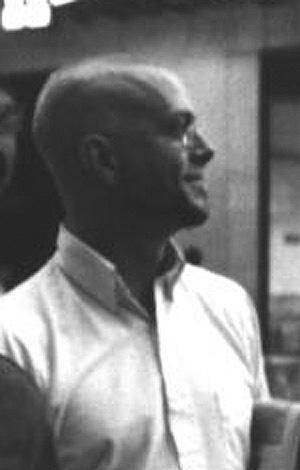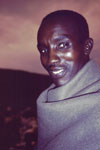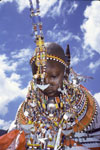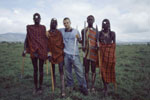The Column: What You Can Do If You Feel Like It, Still
Christian McShane tells the story of Hans who went to Africa and came back with music.





I used to have a studio in one of the worst sections of Duluth. Located between one of the roughest bars in town and the fleabaggiest of fleabag hotels was my place; a 1950s-era grocery store turned 2000 experimental sound chamber. Next door was a video store that became my oasis on long nights (they had a Coke machine). Behind the counter was a young man named Hans Johnson who always seemed full of energy and seemed very interested in what I was up to musically. I began to look forward to our short chats amid the mumblers and heavily medicated individuals that sauntered past both our doors.
“Hey, Christian. Whatcha up to over there? It sounds like whales or something.”
“Oh, I’m just trying to bend the I-beams again.”
Unfortunately, my little studio was also complete with storefront windows perfect for throwing a brick through when curiosity got the best of questionable individuals walking by. I decided to move out.
A year or so later, I happened to be driving around the old part of town during a snowstorm and decided to stop in and see my old friend for some musical prattle. Hans wasn’t there.
“He’s in Africa,” said one of the disinterested faces behind the counter. “Recording, or … something.” Africa? Recording? Further inquiries went nowhere. The new video-store echelon seemed more interested in the Olson Twins movie on the four TV sets bolted to the corners of the room than the fact that their former co-worker was halfway round the world. So began my search. I asked around but no one seemed to know any details. All I got from everyone I spoke to was the same nasal sigh: “He’s in Africa. Recording, or … something.” After a while I gave up.
Summer eventually snuck in one day while Duluth wasn’t paying attention so I decided to take a stroll down Superior Street to check out old architecture and window displays I’d missed over winter’s long, monochromatic days.
“Hey!” came a shout. Nothing unusual about this. On warm days in Duluth, you get a lot of heys on Superior Street. I looked down. I was wearing a tie and my clothes were uncharacteristically unwrinkled. I must have looked like ol’ moneybags.
“Christian!” came echoing from across the street, from a young guy with a pretty rough-looking mohawk. Hans.
Conversations later, I finally got answers.
What Hans Johnson did is remarkable. He went to Africa on a wing and a prayer to record the music of a Maasai tribe. Armed only with a Maasai warrior and guide he’d never met named Simon Sartori (who would later become one of his best friends), a mini-disc recorder, a set of stereo microphones and enough spirit to power a small city, Hans traveled alone to Kenya. When he arrived, it was the first time many Maasai in the area he went to had ever seen a white person. Only one known recording has ever been made of this music. That was in the 1930s and it has since been long lost like so many of the recordings of the day made with unstable techniques.
Hans recorded music that has existed for perhaps thousands of years but that none of us have ever heard before. As musicians and artists, we’re always (or should be) looking for that new sound, that new inspiration, that new thing that keeps us moving forward to keep creating and not stagnating. And I firmly believe we’re all trying to communicate something by doing what we do. Heavy-metal thrasher, jazz pianist, calendar art photographer or avant-garde painter – we’re all trying to say something, aren’t we? Some artists spend their whole lives at the attempt with little or no result. How many of us have actually been successful?
Hans is. Poof – just like that. And he did it not for glory or fame. He just did it.
“Their music and culture are dying,” he told me. But not if Hans has anything to say about it.
What he’s captured is beyond amazing. On his first recording, Music of the Maasai, it’s not only what he recorded that’s worthy of a medal, it’s how he recorded it as well. Put on a set of headphones, close your eyes and you’re … there. Throughout the entire recording, you’re alongside the Maasai, hearing exactly what Hans heard. The microphones Hans used look much like headphones. The microphone designer had a simple idea – whatever is recorded should be picked up exactly how it’s heard in real life – and it works like a dream. On one track, you’re sitting next to a woman singing a lullaby to her newborn child. On another you’re in the middle of a group of young Maasai warriors chanting in laleyio, a rhythmic style of singing. On another, you can almost touch the crickets in the background.
And the music itself? It’s mindblowing. We’re not talking about a group of musicians that are trying to get a record deal. Nor do they care that Madonna kissed Britney or Justin exposed Janet’s boob on cue. They live in huts in the middle of Africa with no electricity. These are people who make music because it’s what they are. It’s the core, the center of nearly all popular western music known today. This is where jazz and blues began. While listening to their music, it’s not hard to tell what we’ve taken and called our own. As musicians and lovers of music, we owe them a lot.
In 2003 Hans took a second trip to Kenya. In the interim, he raised enough financial support for Simon to go to school. This time around, with a bit more experience under his belt, some familiar faces and a longer stay, he recorded hundreds of Maasai songs in the same beautiful true stereo format. Hans recently held a CD release for the fruits of this venture, Rhythm of the Maasai, at Sacred Heart Music Center, Duluth. (Sacred Heart is a beautiful old renovated church here in town that comfortably seats about 500.)
Every once in a while something so honest and good happens in my life that I swear if I brushed up against something sharp, I’d explode rainbows. When I walked in the door of Sacred Heart, it was standing room only. The place was as crowded as a rock concert. At the front was a young man in a white shirt, dwarfed by the huge crowd. It was then that I answered a question that I’ve been asked many times: “Why do you still live in Duluth?”
As Hans began his story, children were hushed, people fell silent.
“Simon asked me if I had ever been the answer to an African’s prayer before. Simon told me, ‘Now you are.’”